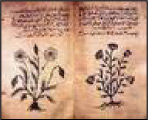Islamic Science Exhibition
By Dr Khan Dawood L. Khan
Chicago, IL
 An
exhibition, “The Golden Age of Arabic Sciences,”
has been organized at the Institute of Arab World in Paris,
France. It has about 200 specimens on display that document
Muslim contributions to sciences. The exhibition is to continue
till 19 March.
An
exhibition, “The Golden Age of Arabic Sciences,”
has been organized at the Institute of Arab World in Paris,
France. It has about 200 specimens on display that document
Muslim contributions to sciences. The exhibition is to continue
till 19 March.
There is report on it (‘A Culture of Knowledge’
by Pete Jeffs) in the February 2 issue of the British journal,
‘Nature’ (Vol. 439: page 536), describing how
the people who produced “exquisite manuscripts, developed
experimental sciences and added new disciplines to those
of classical world,” extended the existing know ledge,
and turned “theory into practice.”
The exhibition includes specimens showing how, e.g., (i)
the optics of Ibn-al-Haytham (965-1040 AD) paved the way
for experimental research in Physics; (ii) al-Khwarizmi
(the father of Algebra) used the mathematics, in 830 AD,
to calculate inheritance, conduct commerce and build canals;
and (iii) Paper that was beginning to replace papyrus, was
first produced industrially in Samarkhand, and later in
Baghdad. It seems about 4 million individual Arabic writings
from the 8th century onward are now in the libraries around
in the world.
One of the objects on display is a planispheric astrolabe
from the Nasser D. Khalili Collection. There is also a beautifully
illustrated copy (in Arabic) of Herbal by Pedanius Dioscorides,
the Greek surgeon/physician, pharmacologist and botanist
who worked in Rome during Nero’s reign. He was the
one who wrote De Materia Medica (5 volumes), perhaps the
most respected herbal medicine book that was in use until
1600. De Materia Medica pre-dates the modern Pharmacopeias.
Some illustrated manuscripts of the Materia Medica from
5th through 7th centuries have survived, some with additions
from Arabic sources. See the Figure for one housed in the
Brtitish Museum.
Arabs used growing knowledge from different disciplines
to build hospitals, observatories and libraries, starting
with ‘Bayt-al-Hikma’ (House of Wisdom) in Baghdad
around 800 AD. Scholars wrote about their work, translated
work by others, traveled around and corresponded with others
in their own and other disciplines. Their work was stored
in thousands of private and public libraries.
The ‘Nature’ report also mentions that “The
Koran, incidentally, encouraged scientific activity.”
The exhibition starts with a map that identifies cities
and places associated with Islamic science.
-------------------------------------------------------------------------------------

